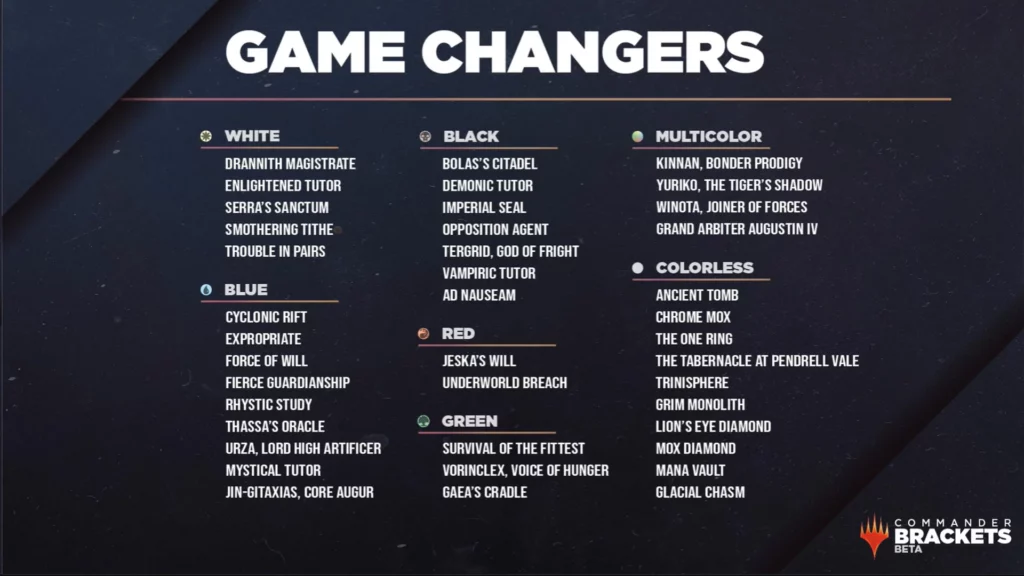Following the recent, and completely unexpected bans that hit the Commander format, MTG’s most popular format hit a massive wave of turbulence. Long story short, the format that was managed by the community has now officially been turned over to Wizards of the Coast. After this change, Wizards promised to create a tier system that would ease matchmaking problems.
Finally, the beta version of the Commander ‘Bracket’ system was presented today during the WeeklyMTG live stream. Game designer Gavin Verhey sat down with Blake Rasmussen to reveal the new Commander Bracket System.
Commander Bracket System

The prototype of the Commander Bracket System functions as a tool that players can use for matchmaking purposes. Ideally, you can use this to create more enjoyable gameplay experiences when playing with strangers at an LGS or at a MagicCon event. This will hopefully help alleviate massive power discrepancies between strangers sitting down to play a game of casual Magic.
Most restrictions on this list are self-explanatory, so we will not review them here. Any extra information about a specific section will be discussed later in the article. The one exception to this is the Game Changer list, which requires a bit more explanation.
What Are Game Changers?

Of all the terms and restrictions listed in each of the Commander tiers, the Game Changers is the biggest deal. This is a list of cards that will function as both the new watchlist for cards that could get banned in Commander and help create a clearer tier system for different Commander power levels.
The number of Game Changers that can be included in a Commander deck differs depending on the tier. More interestingly, cards that will be banned in Commander need to appear on this list before getting banned in Commander.
This solves the biggest issue with the recent Commander bans: the surprise factor. These bans came from absolutely nowhere and completely blindsided players. Unfortunately, the cards banned were very expensive, so a lot of collections were negatively impacted by the changes. Now, this list functions as a warning for players who are concerned that a card will get banned in Commander.
It was also mentioned by Verhey that, after the first change, the Game Changers list may also be a tool used to trial unbanned cards after initial tweaks are made in April. We have been informed to expect a lot of unbanned cards in April.
As a reminder, the Game Changers list does not address some cards that fall under restrictions in some tiers like Winter Orb, Blood Moon, and Time Warp. There are also some cards like Timetwister that are questionably absent from this list. This is a prototype for a reason. Feedback from the community will be assessed and used to make a Game Changers list that represents the Commander format as much as possible.
Tier 1 – Exhibition
To reiterate, Tier 1 is the LOWEST tier among the prototype Commander matchmaking system. These decks are commonly represented to be casual-focused decks that are promoting a wacky strategy that is more about ‘doing the thing’, and less about ‘winning the game.’
Many of the social taboos in casual Commander games are listed here as forbidden things that should not be available in your decks.
Gavin Verhey specifically stated multiple times in this announcement that a lot of the terms of these tiers fall under ‘feel.’ It is technically very possible to build an incredibly powerful Commander deck that falls under the deck construction rules of the Exhibition Tier, but these decks are specifically weaker than the average Commander precon according to the second tier. For that reason, a deck might not necessarily be a Tier 1 deck even though it falls under the deckbuilding constraints of the tier.
Notably, cards that search for lands are not included in any of the tutor restrictions. This means that cards like Rampant Growth are not included as a tutor, even though they technically could be considered one.
Tier 2 – Core
Are you playing a preconstructed deck with a few differences? Chances are your deck falls into the Core category. For the most part, if your deck competes with a preconstructed deck out of the box, but does not overpower it, chances are that your deck is a Tier 2 deck.
The biggest issue with this bracket is that it’s very easy to build a Commander deck that fits within the restrictions of this bracket but is far more powerful than a preconstructed deck. While this technically could be a Tier 2 deck, it is probably better quantified as a Tier 3 deck.
Tier 3 – Upgraded
A Tier 3 deck is where a majority of Commander decks will fall into. If your deck is stronger than a precon but isn’t trying to dominate the table, you are likely playing an upgraded deck.
The restrictions in this category are perhaps the most nuanced and useful. This makes sense since most players are going to have decks between the Tier 3 and 4 brackets. Late-game two-card combos, and three cards from the Game Changers list are the most interesting restrictions in the entire Bracket system. Many content creators who were aware of this list before the announcement have reportedly already made small changes to their decks to follow these restrictions.
Notably, Gavin Verhey offers ‘turns 7-9’ in the reveal announcement as a good way of indicating whether a two-card infinite combo wins in the late game.
Tier 4 – Optimized
This, basically, refers to high-power Commander decks trying to win the game efficiently that may not necessarily be tuned for cEDH play. If your deck is consistently trying to close the game out before the lategame (turns 7-9) and includes multiple tutors, game-changers, extra turn effects, or land restriction effects in it, there’s a good chance your deck is an Optimized one.
The only real difference between Tier 4 and Tier 5 is whether or not your deck is constructed with competitive play in mind. CEDH has its own format with a metagame that needs to be planned for. Optimized decks are unlikely to be prepping for this metagame, and are more likely simply trying to be as powerful as possible in a vacuum.
Tier 5 – cEDH
CEDH was already a sort of tiering system that the Commander community adopted, so it makes sense that Gavin Verhey decided to make this tier its own thing. As mentioned, cEDH decks are specifically built around the cEDH metagame. That is largely the only difference between this tier and the previous one.
Interestingly, depending on the angle you take with your cEDH deck, this could mean that an Optimized Commander deck could give you a tough time. They are unlikely to fall into the cEDH meta and, therefore, can attack you on an angle that your deck is not prepared to compete with.
Basically, unless you’re specifically building a cEDH deck with the intent of it being played in that context, your deck is not a cEDH deck.
What’s Next?
Now that the Commander Bracket Beta system has been implemented, the next step for this system is to gather feedback. Verhey has repetitively stated that Wizards of the Coast is very interested in feedback for the first implementation of the system. The goal is to take the feedback from the community and offer an update sometime during April 2025.
There are already a lot of mixed reviews on the Magic: The Gathering Commander Bracket system, but at an absolute minimum, this system delivers a coherent watchlist for Commander cards to be moved on and off the banlist, which is a massive victory for Magic’s biggest format.


